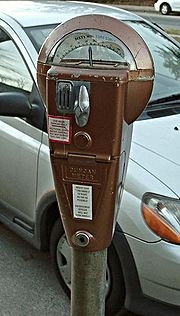- BY Admin
- POSTED IN Articles, Fără categorie
- WITH 0 COMMENTS
- PERMALINK
- STANDARD POST TYPE

A parking meter is a device used to collect money in exchange for the right to park a vehicle in a particular place for a limited amount of time.
STORE OF INVENTIONS & TECHNOLOGIES FOR SALE : https://worldwideinvention.com/store/
Parking meters can be used by municipalities as a tool for enforcing their integrated on-street parking policy, usually related to their traffic and mobility management policies.
History
1940 Parking Meter
The parking meter was invented in 1935 by Carl C. Magee in Oklahoma City, OK. The world’s first installed parking meter was in Oklahoma City, Oklahoma on July 16, 1935. Industrial production started in 1936 and expanded until the mid ’80s. The first models were based on a coin acceptor, a dial to engage the mechanism and a visible pointer and flag to indicate expiration of paid period. This configuration lasted for more than 40 years, with only a few changes in the exterior design, like the double-headed version and the incorporation of new materials and production techniques.
In 1960, New York City hired its first crew of “meter maids”, all were women. It was not until 1967 that the first man was hired.
In the mid ’80s, a digital version was introduced, replacing the mechanical parts with electronic components: boards, keyboards and displays. This allowed more flexibility to the meter, as an EEPROM chip can be reconfigured more easily than corresponding mechanical components.
By the beginning of the ’90s, millions of parking meter units had been sold around the world, but the market was already looking into new solutions, like the collective pay and display machines and new forms of payment that appeared along with electronic money and communication technologies.
Security issues
Parking meters are exposed to the elements and to vandals so protection of the device and its cash contents is a priority.
Some cities have learned the hard way that these machines must be upgraded regularly, essentially playing an arms race with vandals. In Berkeley, California, the cut-off remains of meter poles were a common sight during the late 1990s, and parking was largely free (and anarchic) throughout the city until the city government installed digital parking meters with heavier poles in 2000 (which were eventually vandalized as well).
Other cities have turned to having meters accept only cards that serve this purpose (such as smart cards). However, the expensive card-reading device inside has replaced the money as targets of theft.
Legality
Parking meters have been challenged in court many times, but are considered legal if the parking meters used for purposes of parking regulation and not for revenue purposes. In an 1937 case in Oklahoma , H.E. Duncan contended that the ordinances impose a fee for the free use of the streets, which is a right of all citizens of the state. The Courts ruled that free use of the streets is not an absolute right, but agreed with an unpublished 1936 Florida court decision that said, “If it had been shown that the streets on which parking meters have been installed under this ordinance are not streets where the traffic is sufficiently heavy to require any parking regulations of this sort, or that the city was making inordinate and unjustified profits by means of the parking meters, and was resorting to their use not for regulatory purposes but for revenue only, there might have been a different judgment.”
The Supreme Court of North Carolina judged that a city could not pledge on-street parking meter fee proceeds as security for bonds issued to build off-street parking decks. The court said, “Streets of a municipality are provided for public use. A city board has no valid authority to rent, lease or let a parking space on the streets to an individual motorist ‘for a fee’ or to charge a rate or toll therefor. Much less may it lease or let the whole system of on-street parking meters for operation by a private corporation or individual.”
More recently, however, Chicago agreed in December 2008 to privatize their 36,000 parking meters for $1.15 billion in revenue. A partnership between Morgan Stanley and LAZ Parking will purchase the 75-year lease on the parking meters and revenue collection. The Chicago parking meter privitization deal has resulted in meter boycotts, vandalism, and political problems for the Daley administration as hourly rates have been increased.
The legality of this privatizing agreement is being challenged. In August 2007, the Independent Voters of Illinois/Independent Precinct Organization (IVI-IPO) filed suit in Cook County Court in an attempt to overturn the city’s privatization of parking meters.
The suit, docket # 09CH28993, asks the court to declare the contract between the city and Chicago Parking Meters, LLC, illegal and void. The deal between the city and CPM violates state law because: the city did not have authority to lease city streets; the city cannot delegate police functions (parking enforcement) to a private company; the city cannot, through the 75-year lease, deprive future City Councils from the chance to exercise control over city streets; and the city cannot ask the Illinois Secretary of State to suspend driving privileges for violations at privately-held meters.
The very first parking meter ticket resulted in the first court challenge to metered parking enforcement. Rev. C.H. North of Oklahoma’s City’s Third Pentecostal Holiness Church had his citation dismissed when he claimed he had gone to a grocery store to get change for the meter.
Operation
Parking meter in Downtown Houston, Texas, United States
By inserting coins into a currency detector slot or swiping a credit card or smartcard into a slot, and turning a handle (or pressing a key), a timer is set within the meter. Some locations allow payment by mobile phone (to remotely record payments for subsequent checking and enforcement). A dial or display on the meter indicates the time remaining.
In many cities, all parking meters are designed to use only one type of coin. Use of other coins will fail to register, and the meter may cease to function altogether. For example, in Hackensack, New Jersey all parking meters are designed for quarters only.
Some newer parking meters have a sensor that can determine when a parking space has been vacated. Once this happens, any remaining time on the meter resets to zero, forcing the next driver to pay the full price for parking. This feature can also be used to enforce maximum parking times by requiring that the parking space be vacated before allowing any additional time to be purchased. This makes it more difficult for the driver to simply return and purchase additional time, or for a “good samaritan” to pay for more parking on the driver’s behalf (sometimes called “feeding the meter”).




